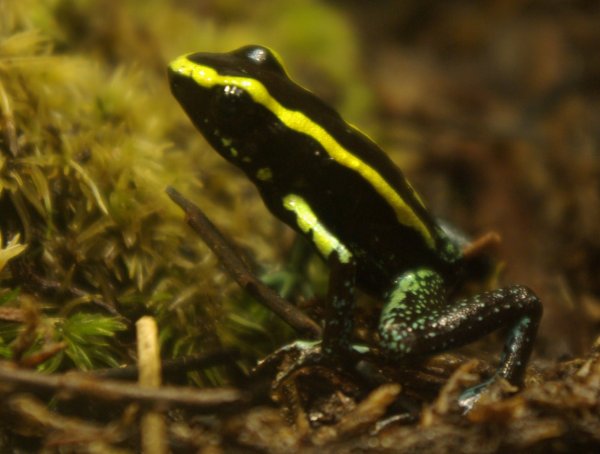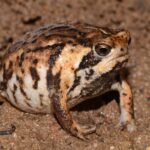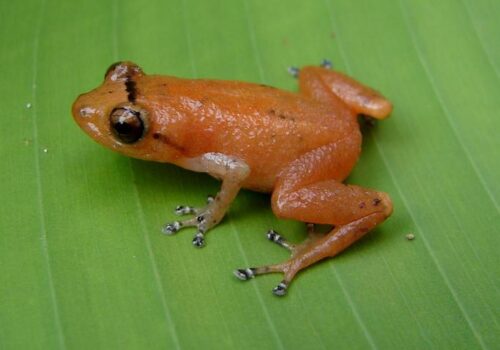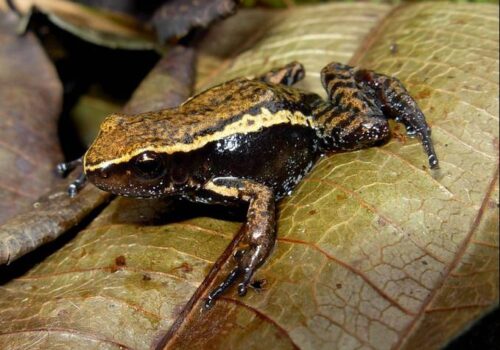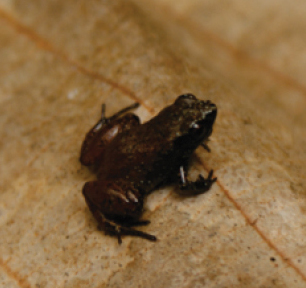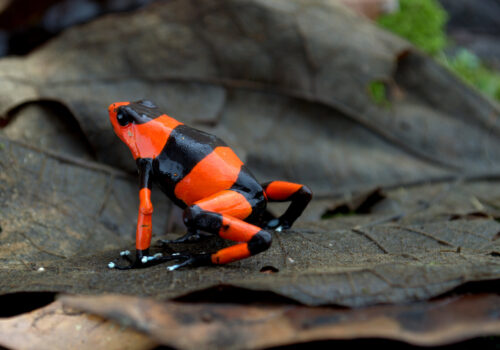- Golden-Striped Poison Frog (Phyllobates aurotaenia): Secrets of Colombia's Tiny and Toxic Jewel
Golden-Striped Poison Frog (Phyllobates aurotaenia): Secrets of Colombia’s Tiny and Toxic Jewel#
Hidden among leaf litter on the lush forest floor of Colombia’s serene rainforest slopes lurks one of nature’s most vibrantly colored yet dangerously toxic amphibians: the golden-striped poison frog, scientifically known as Phyllobates aurotaenia. Though smaller than your thumb, this striking creature commands respect—not through size or aggression, but through potent toxins and dazzling, jewel-like coloration that warns predators from afar.
Yet this exquisite little frog represents more than just visual wonder: it’s an ecological sentinel, a crucial link in its tropical ecosystem, and an intriguing subject for scientists and conservationists worldwide. In exploring the fascinating life, behavior, and conservation challenges facing P. aurotaenia, we discover a narrative both captivating and sobering, shining a necessary spotlight on the delicate beauty and fragile balance of our planet’s unique wildlife.
Taxonomy and Classification#
The golden-striped poison frog, scientifically named Phyllobates aurotaenia, belongs to the Dendrobatidae family of colorful, mostly diurnal frogs, commonly known as poison dart frogs. These frogs have long fascinated scientists and nature lovers alike, famous simultaneously for their stunning appearances and potent defense mechanisms.
First described scientifically in 1913 by zoologist George Albert Boulenger, Phyllobates aurotaenia shares its genus with several closely related species, notably Phyllobates terribilis—famously known as the most toxic vertebrate in the animal kingdom. While P. aurotaenia is not as lethal as its cousin, the toxins it harbors are still remarkably powerful, granting it a distinguished position among Colombia’s diverse and intriguing amphibian fauna.
Natural Habitat#
From mist-drenched cloud forests to shadow-laden tropical lowlands, Colombia offers ideal conditions for diverse amphibian life. The golden-striped poison frog inhabits humid, well-preserved rainforests within confined geographic ranges, particularly along the lush slopes of the Andean foothills in western Colombia.
Geographic Range and Distribution#
Phyllobates aurotaenia is native exclusively to Colombia, typically found between elevations of 50 to 700 meters above sea level. Populations exist scattered across the Pacific slopes of the Cauca and Valle del Cauca departments, particularly within the foothills of the western Andes, regions known for their exceptional biodiversity and endemic amphibian species.
Specific Habitat Preferences#
Golden-striped poison frogs thrive within dense rainforest understories, shaded by towering trees and enveloped by consistent humidity and warmth. Thick leaf litter carpets the damp forest floor, providing ideal shelter, breeding grounds, and safe hunting territories. These frogs are most at home among layers of decomposing leaves, fallen branches, and moist vegetation bordering small forest streams or seepages—conditions essential to their daily routine and reproductive success.
The interplay of frequent rainfall, mild temperatures, and lush, multi-layered vegetation sets the perfect stage for these brilliantly colored amphibians, providing the stability required in their microhabitats.
Physical Characteristics#
To spot the secretive golden-striped poison frog amidst the jungle foliage is to encounter vibrancy embodied. Measuring only 2 to 3 centimeters in length, these frogs may be tiny but are impossible to overlook. Their skin glows vividly—an arresting mosaic of jet-black backgrounds intersected by striking, bright gold or orange longitudinal stripes running from their snouts down their backs, limbs, and sides.
Coloration and Defense#
Nature seldom adorns creatures with bold colors by accident, particularly in amphibians inhabiting predator-rich rainforests. For poison dart frogs like P. aurotaenia, bright coloration profoundly serves as an aposematic warning: a biological billboard advertising its potent poisonous nature. Predators, following evolutionary lessons of taste and survival experiences, often recognize these bold colors, choosing wisdom over curiosity to avoid severe discomfort or worse.
Toxins and Adaptations#
The poison harbored within the skin glands of the golden-striped poison frog belongs predominantly to the class of alkaloids known as batrachotoxins—some of the most powerful natural toxins on earth. Remarkably, these frogs do not synthesize the toxins themselves; rather, they acquire them through ingestion of toxic forest arthropods, primarily ants and mites. As a result, frogs bred in captivity lose their toxicity over time—a testament to the interdependent ecosystems and dietary habits essential for toxin production.
Behavior and Life Cycle#
Solitary yet vocally expressive, golden-striped poison frogs demonstrate fascinating behaviors woven intricately around their rainforest home. They are mostly diurnal animals, actively hunting by daylight and cautiously resting after sunset within secure, moisture-rich hiding spots.
Hunting and Feeding Habits#
With precise movement, P. aurotaenia stalks its insect prey, capturing ants, mites, springtails, and other small arthropods with rapid flicks of its sticky tongue. This specialized diet helps maintain their chemical defenses, highlighting how deeply interconnected their lives are with their native habitats.
Reproduction and Parental Care#
Mating for golden-striped poison frogs is a captivating, ritualized affair. Males engage in elaborate vocal performances to attract females, typically from sheltered vantage points within the leaf litter. Courtship culminates in the laying of small clusters of gelatinous eggs hidden from predators beneath moist leaves or embedded securely in leaf litter, guarded attentively by males.
After eggs hatch into delicate tadpoles, adults exhibit remarkable levels of parental care. Males transport young tadpoles carefully onto their backs, delicately ferrying them to small pools of water or water-filled plant cavities among bromeliads, where each tadpole can safely grow into adulthood, nurtured by nature itself.
Ecological Role#
The golden-striped poison frog’s role transcends its diminutive size, influencing complex relationships within rainforest ecosystems. As active predators of abundant insect populations, they aid in controlling insect densities, indirectly influencing plant health and biodiversity through food web dynamics.
Simultaneously, as prey, juvenile frogs or tadpoles occasionally fall victim to certain predators immune to their toxins—such as specialized snakes and spiders. Clearly, Phyllobates aurotaenia plays an essential part in shaping rainforest ecology, acting as both predator and a selective force upon other rainforest species.
Threats and Conservation Status#
Despite their potent defenses, golden-striped poison frogs face escalating threats from habitat destruction, climate change, pollution, and disease—all global-scale issues disproportionately affecting sensitive amphibians. As rainforest habitats shrink dramatically due to logging, agriculture, mining, and human encroachment, populations of these valuable frogs dwindle alarmingly.
Currently listed as ‘Near Threatened’ on the IUCN Red List, this frog demands immediate attention and protection. Conservationists emphasize habitat preservation, restoration programs, captive breeding projects, and comprehensive research into population trends and ecology to ensure their continued survival.
Cultural and Scientific Significance#
Indigenous communities within Colombia have historically acknowledged the potency of frog-produced batrachotoxin, utilizing it to coat dart tips for hunting and protecting their territories. Scientific interest regarding P. aurotaenia holds potential insights into pharmacology, especially concerning nerve function or pain management given its potent biochemicals.
Moreover, frogs of genus Phyllobates continue to enchant biologists worldwide, serving as powerful indicators of the broader environmental health of sensitive rainforest regions, offering clues about the planet’s fragile ecological balance.
Conclusion: Preserving Colombia’s Hidden Toxic Treasure#
In the quiet, shadow-rich understory of Colombia’s rainforests, the golden-striped poison frog serves as a small yet dazzling reminder of nature’s astonishing complexity and fragility. These frogs embody interconnected environmental stability, carrying allure for indigenous traditions, scientific research, and natural beauty.
To preserve these remarkable frogs is to protect a vital link within the rainforest tapestry—one that benefits not only this tiny, vibrant amphibian but an entire intricate ecosystem. By supporting conservation initiatives and advocating responsible ecological stewardship, each of us holds the potential to help safeguard Colombia’s incredible and toxic hidden treasure—Phyllobates aurotaenia.






